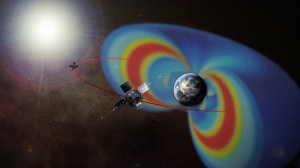
A new method developed by Skoltech, MIT and UCLA researchers allows to restore the current state of the radiation belts in the Earth’s Magnetosphere. Image courtesy: NASA
More than a thousand operational satellites are currently orbiting the Earth and each of them is prone to the severe disturbances known as “space weather”. Now researchers from Skoltech, UCLA and MIT have developed a method that allows to restore the current state of the radiation belts in the Earth’s magnetosphere and predict its evolution. This “space forecast” is usually based on sparse observational data. Yet the team of Russian and American scientists has been able to improve its accuracy to an unprecedented level, as they report in the Journal of Geophysical Research (JGR), Space Physics. Researchers believe the new method might also be used for weather forecasting and the dynamics of the oceans.
Working in space could be a nightmare mission when it comes to sensitive electronics. When outside of the protection of atmosphere, devices operate under a heavy bombardment of high-energy particles originating mainly from the Sun and trapped in the Earth’s magnetic field. The intensity of radiation can vary in orders of magnitude, depending on solar wind conditions as well as on processes inside the magnetosphere. In order to determine where and when space equipment might fail, researchers and space agencies must constantly monitor the space environment with research satellites.

Professor Yuri Shprits, Skoltech, co-author of the Magnetospheric Reconstruction study
However, raw satellite data is not enough, says Skoltech professor Yuri Shprits. “One of the major difficulties in understanding space environment is that observations are limited to a particular point in space and time while applications require a global and continuous coverage”, explains Shprits. The method developed by him and his co-authors allows reconstruction of the entire radiation belts. Their findings, along with the method which made those possible, are published in two papers in the Journal of Geophysical Research (JGR), Space Physics (see links here and here).
“Our model works similar to a GPS navigation device like the one you use in cars,” says Shprits, “a navigation device assumes that when you are moving at a speed of, say, 70 kmph, in five seconds you are likely to be about a hundred meters away from the previous spot. When the tracker receives new data from satellites it blends this model with new data to calculate new coordinates. This requires the usage of a mathematical model of the moving vehicle. We analyze the evolution of the magnetosphere in a similar way but our model is much more sophisticated”.
The prominent feature of the new method is that it makes it possible to determine both the uncertainties of the physical model of near-space environment and uncertainties of the satellite observations in order to combine those in an optimal way to achieve reconstruction with guaranteed accuracy. “This method is applicable not only to the studies of the space environment, but also can be used for weather forecasting, in the studies of ocean dynamics, and for a number of studies that utilize large amounts of measurements,” adds Tatyana Podladchikova, a Skoltech postdoc and the first author on both of JGR publications. “The satellite data flow nowadays is so huge that development of new methods of handling it is as important as launching new satellites”.
By utilizing the new method authors plan to create an online service where the current state of the magnetosphere can be monitored in real time. They also intend to look through the archive satellite data in order to reconstruct the state of space weather in the past. Earlier Shprits’s group have managed to explain the unusual behavior of high-energy particles in the near-Earth space environment in August 2012, when the two well-known Van Allen radiation belts were joined by a temporary third one. The new method will allow to “replay” this and other unusual moments in the history of the magnetosphere over the past couple of decades.

Tatiana Podladchikova, Skoltech postdoc and the first author on both of JGR publications
* The Skolkovo Institute of Science and Technology (Skoltech) is a private graduate research university in Skolkovo, Russia, a suburb of Moscow. Established in 2011 in collaboration with MIT, Skoltech educates global leaders in innovation, advances scientific knowledge, and fosters new technologies to address critical issues facing Russia and the world. Applying international research and educational models, the university integrates the best Russian scientific traditions with twenty-first century entrepreneurship and innovation.
